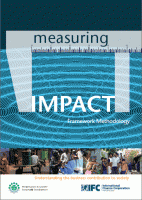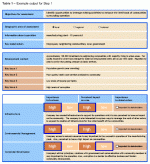In order for a form of measurement to be truly accurate it has to be implemented by a group, not a set of individuals. For instance, it’s much easier for a group of five people to measure a thousand paces (the old mile) than five people counting a thousand paces individually.
This is why the World Business Council for Sustainable Development (WBCSD), in conjunction with the International Finance Corporation (IFC), has recently launched the Measuring Impact Methodology (MIM).
The flaw it seeks to address is one of the oldest in the book: how can different companies produce comparable figures open to close analysis if they all use different methodologies to do the measuring.
The area the framework aims to bring this rigour to is their impact among the most nebulous stakeholders: the communities within which they operate.
Stating the Outcome, Not Guessing the Result
Attempts have been made before to introduce mechanisms into business to measure their impact upon the wider community. The most widely known is the Environmental Impact Assessment (EIA).
These have been around in one form or another for over 20 years. Their place has always been as part of the project planning process in an attempt to gauge the likely impact a project will have on the wider environment.
WBCSD’s Measuring Impact Methodology is different. It aims to measure the impact a business has had upon the wider community after the event.
In this sense it is a crucial part of the sustainability measurement and compliance jigsaw which is being built up. To date there has been no framework governing how companies do this, leaving the whole area open to interpretation and the spin of greenwashing.
Now, however, companies have a framework to work within when assessing and reporting the impact they have had upon the wider community.
Although only voluntary, companies who choose to operate outside this framework will always draw the cynical journalist who will look for the additional spin a company may be trying to introduce.
The 4×4 Solution
The framework itself is remarkably simple and rests upon four steps which a company should go through:
- Set Boundaries; define the project in terms of the business activities to be considered and the geographic area in which they are occurring
- Measure the Direct and Indirect Impacts; identify those impacts under the company’s direct control and those which are not but which are influenced by the company’s activities
- Assess Contribution To Development; engage with stakeholders in the community in order to gauge how the company is supporting their development priorities
- Prioritise Management Response; plan a response to the impact the company has had, based upon the risks and opportunities identified in previous steps
The framework also defines four classes of business activities which companies should report against:
- Governance and Sustainability; the impact the company’s policies and procedures have on the wider community, including anything specifically targeted at environmental management
- Assets; the impact anything “owned” by the company has, including premises and infrastructure and how products and services are created and delivered
- People; the roles people fulfil within the company, their skills and training
- Financial Flows; the financial impact a company has within it community, typically through procurement and taxation
Nice And Easy Does It
The framework includes a detailed explanation of the various activities a company needs to go through in order to complete each step.
However unlike many others the methodology includes a macro-driven Excel spreadsheet. This gives the methodology two advantages in usability over many others.
Firstly it provides a readymade electronic reporting application so the company doesn’t need to produce its own, spend extra money buying one from a consultancy or print out an onerous amount of paper detailing all the check boxes and comment fields..
Secondly it allows personnel to learn about the framework in a very hands-on manner, reading about the steps and going through them in a hypothetical example at the same time.
Indirect Impacts
Overall this is a very welcome addition to the growing armoury of methodologies being published to help companies understand and improve the sustainability of their business processes.
It also breaks new ground in that it measures the impact of company activities after the event, rather than trying to project them and then measure how a company has performed against that target.
In addition, the inclusion of a multi-functional spreadsheet in the methodology is also welcome and one has to wonder whether other organisations will start to provide similar tools as part of their methodologies.
After all, business lives by the rationale that competition between different organisations in products and services is healthy for society. There’s no reason providers of schemes and standards should be any different!
A former CTO, Chris has a broad and varied background. He’s been involved with blue chips, consultancies & SMEs across a wide variety of sectors and has worked in Europe, the Middle East and Australia.
In 2007 he decided to combine his knowledge of business and IT with his passion for all things sustainable and has been busy writing ever since. However, his greatest ambition remains to brew the perfect cup of coffee.





